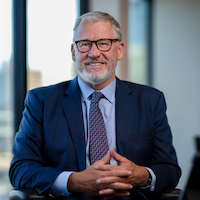Finding value in times of turmoil
By Justin Cleveland

Despite the extreme volatility in the markets, savvy managers are still able to find value.
Diversification has always been a hallmark of a sound investment strategy and that remains true today says First Sentier Investors co-head of multi-asset solutions, Kej Somaia. "The key difference this time is that the changes in the economy are fundamentally different in their speed and magnitude and depth, and we've had to speed up our own process."
Somaia says flexibility is key to finding ways to extract value for investors. "We have to review our economic climate assumptions much more regularly - even on a daily basis - not every six months as we would normally."
While health and policy specialists are able to point to past pandemics, like the outbreaks of SARS, Ebola, or the 1918 Spanish flu, to understand trends and make moves for the future, investment specialists don't have much of a precedent to rely on. "Instead of looking for qualitative similarities, we look at the world more statistically for times of high turbulence, because that's what has been common to all crises.
"The statistical overlay provides more insight and we think is a smarter way to understand correlations and inform us about volatility, or risk more broadly."
That's why Somaia believes multi-asset strategies are particularly advantageous during these times, as they allow fund managers to pivot quickly as circumstances change. For example, when markets are projected to turn sharply downward, multi-asset can focus on capital preservation because of a combination of neutral asset allocation (invested directly in securities like bonds and equities) and dynamic asset allocation (synthetic securities).
"We've been taking a defensive stance - we're at about half our usual exposure for equities, as defined by our NAA. Maybe equity markets will look through the short term - but in reality we think we're going to see negative results by large number of corporates in coming months with some earnings falling by 45% or more," said Somaia.
There's gold in them thar hills
As a sign of the times, Somaia says gold has become more attractive. "We typically avoid gold because it doesn't generate income, making the opportunity cost high. But with cash rates where they are, that opportunity cost has come down. And if inflation rises, gold can provide protection. But for now, we think gold can be a great diversifier."
Emerging markets the rally of the future?
Even before the COVID-19 crisis hit, emerging market debt was an attractive area for growth. Kevin Ritter and Mark Hughes from Western Asset (a Legg Masson affiliate manager) say that, in recent weeks, emerging markets have reduced benchmark interest rates and boosted liquidity to help ease shock on local economies.
"We are already seeing a wide variety of planned fiscal relief programs in EM countries to combat fallout from the virus," they say. "Much like recent trends in the US investment-grade market, we are expecting EM sovereign issuance to come with a significant concession for the foreseeable future, as exemplified by recent sovereign issues from Panama, Israel and Qatar."
"Within the lower quality EM universe, we see significant divergence between issuers, with stressed credits such as Ecuador and Lebanon recently announcing restructurings, but BBB and BB rated credits watching for their opportunity to come to market as the post-virus recovery progresses."
As with past crises, Western Asset anticipates that the first deals back to the market will be the best. "While we acknowledge that EM economies have unique exposure to both COVID-19 and the oil price crash, we still find value in the higher quality part of the market-a strategy that lines up with Western Asset's recent views on value in the US investment-grade market."
EM experts from Amundi Asset Management also see growing value in EM external debt, particularly in high yield where spread have already widened to global financial crisis levels. "We see ample value in Bahrain and Indonesia. We think quasi-sovereign debt in Latin America offers attractive risk/reward scenarios across Brazil, Mexico and Peru. Within local debt, our preference is for EM rates, where we see value in Russian assets across both FX and rates. In Mexico and South Africa, we see value in rates, but not in FX."
Should we be concerned about inflation
With cash rates at historic lows - and unlikely to change for a while - inflation is likely to become a concern in the medium-to-long term. "A real return fund needs to achieve its objectives after inflation. Our strategies are designed to provide investment returns for real spending in retirement.
"While we expect to see low inflation or even deflation in the next few quarters, once we come out on the other side, the amount of stimulus being put into the system could see it emerge as an issue in time to come," Somaia said.
Interestingly, Amundi EM specialists think the post-coronavirus world will lead us toward a de-globalised financial world, a trend that had already started before the crisis. "This will lead to a focus on new investment opportunities within 'specific regions' beyond the traditional geographical perspective. The new Silk Road is one important example of this concept, based on the growing influence of China in the geopolitical landscape and beyond Asia."



